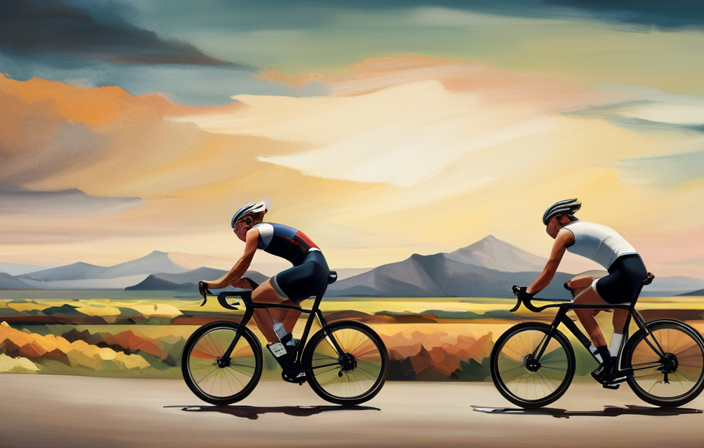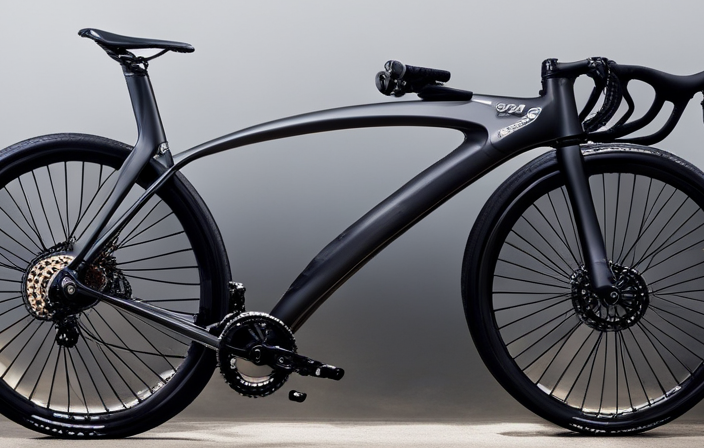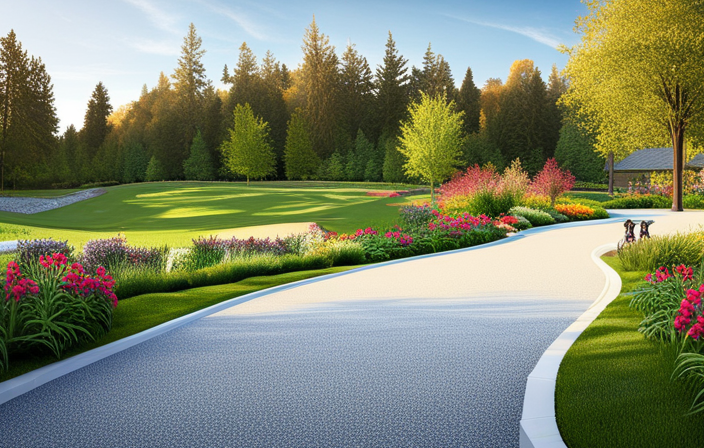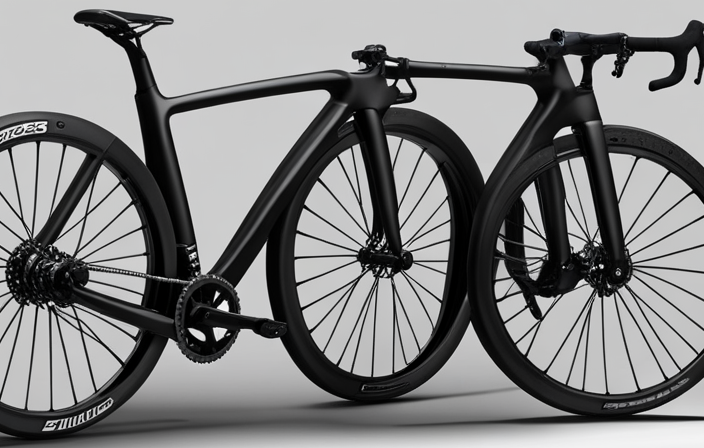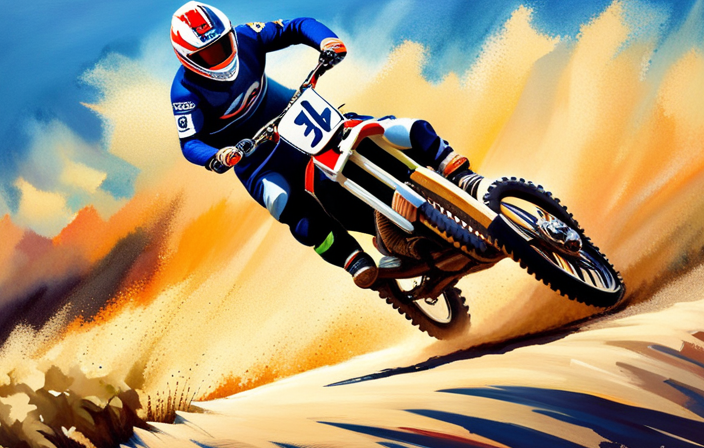Imagine this scenario: you’re riding your gravel bike, tackling tough landscapes and challenging your endurance to its fullest. However, suddenly, your arms begin to feel sore, and the strain starts to feel too much. Don’t worry, my fellow biking enthusiast!
In this article, I will guide you through evidence-based techniques to reduce arm stress while riding a gravel bike. From proper bike fit and handlebar choices to effective riding techniques and essential accessories, we’ll explore everything you need to know for a comfortable and enjoyable ride.
So saddle up as we embark on this journey towards arm-saving bliss!
Key Takeaways
- Seek professional bike fitting services for personalized adjustments
- Maintain a relaxed grip on the handlebars and keep arms slightly bent to absorb bumps in the terrain
- Incorporate suspension components and optimize tire pressure for better shock absorption and conformity to the surface
- Use padded gloves and arm protection to reduce pressure points, absorb shock, and enhance control
Proper Bike Fit
Proper bike fit is essential for reducing arm stress on a gravel bike. Making the right adjustments to your bike fit can help alleviate strain on your arms, shoulders, and wrists, allowing for a more comfortable and enjoyable ride.
One option is to seek professional bike fitting services. These experts have the knowledge and experience to assess your body’s biomechanics and make personalized adjustments to your bike. They can analyze factors such as saddle height, handlebar reach, and stem length to ensure optimal alignment. By fine-tuning these aspects of your bike fit, you can reduce the amount of weight placed on your arms, thus minimizing arm stress.
Another important aspect of proper bike fit is selecting appropriate grips and handlebars. Grips with ergonomic designs can provide better support for your hands, reducing pressure points and discomfort. Additionally, choosing handlebars with a wider flare or drop can offer a more relaxed hand position that alleviates strain on the wrists and forearms.
By focusing on proper bike fit adjustments and selecting suitable grips and handlebars, you can significantly reduce arm stress while riding your gravel bike. This will not only enhance comfort but also contribute to improved performance on those long rides without compromising control or stability when navigating rough terrains ahead in subsequent sections about ‘grips and handlebars’.
Grips and Handlebars
Using ergonomic grips and handlebars can help with alleviating strain on your arms while riding a gravel bike. These specially designed components are aimed at reducing pressure on your hands, wrists, and forearms, allowing for a more comfortable and enjoyable riding experience.
One option to consider is using grip tape on your handlebars. Grip tape provides a textured surface that improves traction, preventing your hands from slipping during bumpy rides. It also absorbs vibrations, reducing the impact on your arms. Look for grip tape that is specifically designed for gravel biking to ensure optimal performance.
Another important factor to consider is choosing ergonomic handlebars. These handlebars are designed with a variety of shapes and sizes to accommodate different hand positions and provide better support for your wrists. They often feature flared drops or wider tops that allow for multiple hand placements, reducing stress on specific areas of the arm.
Incorporating these ergonomic grips and handlebars into your gravel bike setup can significantly reduce arm stress during long rides. By providing better comfort and support, they enable you to ride longer without experiencing discomfort or fatigue in your arms.
Transitioning into the subsequent section about correct riding technique: With the right equipment in place, it’s essential to complement it with proper riding technique.
Correct Riding Technique
To ride with optimal technique, it is crucial to maintain a relaxed grip on the handlebars and keep your arms slightly bent to absorb any bumps in the terrain. Gripping too tightly can cause unnecessary tension in your arms, leading to increased fatigue and discomfort. By allowing the bike to move freely beneath you and maintaining stability, you can reduce arm stress.
In addition to a relaxed grip, body positioning also plays a significant role in reducing arm stress. When riding on rough terrain, it is important to shift your weight back slightly and engage your core muscles to stabilize yourself. This will help distribute the impact of bumps throughout your entire body rather than solely relying on your arms.
By utilizing correct riding technique with a relaxed grip and proper body positioning, you can greatly reduce arm stress while riding a gravel bike. However, it is also important to note that suspension and tire pressure play crucial roles in absorbing shock and minimizing vibrations. In the subsequent section about ‘suspension and tire pressure,’ we will further explore how these factors contribute to reducing arm stress on gravel bikes.
Suspension and Tire Pressure
When it comes to reducing arm stress on a gravel bike, there are two key points to consider: adding suspension components and adjusting tire pressure.
Adding suspension components, such as a front fork or seatpost suspension, can help absorb the impact of rough terrain and reduce vibrations felt through the handlebars.
Additionally, adjusting tire pressure can also contribute to a smoother ride. By allowing the tires to better conform to the surface and provide more grip, you can greatly improve your comfort and enjoyment while out on the gravel trails.
By incorporating these techniques into your riding technique, you can greatly improve your comfort and enjoyment while out on the gravel trails.
Adding Suspension Components
Adding suspension components can help reduce arm stress on a gravel bike. Bike suspension plays a crucial role in absorbing the impact of rough terrain, smoothing out the ride and reducing stress on your arms.
By incorporating suspension forks or seatposts into your gravel bike setup, you can improve comfort and control over uneven surfaces. These components work by compressing and rebounding to absorb shocks from bumps and vibrations, effectively minimizing the transfer of force to your arms.
Additionally, optimizing bike geometry can further enhance the performance of suspension components. A slack head angle and longer wheelbase contribute to better stability and handling, reducing arm fatigue on bumpy rides.
Adjusting tire pressure for a smoother ride is another important factor to consider when aiming to reduce arm stress while riding a gravel bike.
Adjusting Tire Pressure for a Smoother Ride
Adjusting tire pressure can contribute to a more comfortable and smoother ride on uneven surfaces. The right tire pressure can help absorb shocks from gravel and reduce arm stress while riding a gravel bike. When it comes to bike tire selection, it’s important to choose tires with wider widths and lower pressure ratings. Wider tires provide better traction, stability, and shock absorption on rough terrains. Lower pressure allows the tires to conform better to the surface, providing a smoother ride. However, it’s essential to find the right balance as too low of a tire pressure can increase the risk of pinch flats or rim damage. Regular bike tire maintenance is also crucial for optimal performance and comfort. Checking tire pressure before each ride and ensuring proper inflation will ensure a smooth journey ahead.
Transitioning into padded gloves in the next section, wearing them can further enhance comfort by reducing vibrations transmitted through the handlebars without compromising control over the bike.
Padded Gloves
Wearing padded gloves can help reduce arm stress while riding a gravel bike. Proper bike fit and riding technique are essential for minimizing strain on your arms when gravel biking. However, even with the best setup, long rides on rough terrain can still take a toll on your hands and wrists. That’s where padded gloves come in.
Padded gloves provide an extra layer of cushioning that absorbs shock and vibrations from the road. This helps to reduce the impact felt by your arms, relieving stress and fatigue. Here are three reasons why padded gloves are a great investment for gravel bikers:
-
Increased Comfort: The padding in these gloves provides a comfortable grip on the handlebars, reducing pressure points and preventing numbness or tingling in your hands.
-
Shock Absorption: Gravel roads can be bumpy and uneven, causing jolts that transfer through the bike to your arms. Padded gloves absorb these shocks, protecting your joints and muscles.
-
Enhanced Control: With less strain on your arms, you’ll have improved control over your bike. This allows you to better navigate tricky sections of terrain without compromising stability or risking injury.
By wearing padded gloves during your rides, you can significantly reduce arm stress and enjoy a smoother cycling experience overall. Transitioning into strengthening exercises will further improve your gravel biking performance without sacrificing comfort or safety.
Strengthening Exercises
Engaging in strengthening exercises can enhance your performance and improve the overall experience of gravel biking. These exercises target the muscles used during cycling, helping to build strength, endurance, and stability. By incorporating regular strengthening exercises into your training routine, you can reduce arm stress and prevent injuries.
Here is a table that outlines three effective strengthening exercises for gravel bikers:
| Exercise | Targeted Muscles | Benefits |
|---|---|---|
| Push-ups | Chest, shoulders, triceps | Builds upper body strength and stability |
| Plank variations | Core muscles | Improves core strength and stability |
| Dumbbell curls | Biceps | Increases arm strength for better control |
These exercises specifically target the muscle groups involved in maintaining proper bike handling and body positioning on rough terrains. Incorporating them into your training routine will not only help reduce arm stress but also improve your overall performance on the bike.
Transitioning into the subsequent section about ‘proper nutrition and hydration,’ it is important to note that while strengthening exercises are crucial for injury prevention and enhancing performance, they should be complemented by a well-balanced diet and adequate hydration.
Proper Nutrition and Hydration
When it comes to reducing muscle fatigue, staying hydrated is essential. Proper hydration helps maintain optimal muscle function and prevents cramping and stiffness.
Additionally, consuming foods with anti-inflammatory properties can further support muscle recovery and reduce post-exercise soreness.
Staying Hydrated to Reduce Muscle Fatigue
To stay hydrated and reduce muscle fatigue while riding your gravel bike, make sure you drink plenty of water throughout your ride. Hydration is crucial for maintaining performance and preventing muscle cramps.
It is recommended to consume around 500ml of water every hour during exercise, but this may vary depending on factors such as temperature and intensity of the ride. In addition to water, electrolyte-rich sports drinks can also be beneficial in replenishing essential minerals lost through sweat.
To further enhance your hydration strategy, consider incorporating strengthening exercises into your routine. These exercises, such as forearm curls or wrist extensions, can help improve grip strength and reduce arm stress when gripping the handlebars.
By staying properly hydrated and engaging in strengthening exercises, you can minimize muscle fatigue and optimize your performance on the bike. Transitioning into consuming foods with anti-inflammatory properties will provide additional benefits to aid in recovery without compromising step continuity.
Consuming Foods with Anti-Inflammatory Properties
Incorporating foods with anti-inflammatory properties into your diet can aid in recovery and optimize performance on the bike. Consuming foods rich in omega-3 fatty acids, such as salmon, walnuts, and flaxseeds, can help reduce inflammation in the body. Omega-3 fatty acids have been shown to decrease muscle soreness and promote faster recovery after exercise. Additionally, incorporating other anti-inflammatory foods like berries, leafy greens, and turmeric can further support muscle repair and reduce arm stress.
To complement a healthy diet, pre-ride warm-up techniques are crucial for preparing your body for the demands of cycling. Dynamic stretches targeting the arms and upper body can help increase blood flow to these muscles and loosen them up before hitting the gravel. By incorporating these warm-up exercises along with a diet rich in anti-inflammatory foods, you can effectively reduce arm stress during your rides.
Transitioning into the next section about posture and body positioning without using ‘step,’ it is important to have proper alignment on the bike to minimize strain on your arms and maximize comfort while riding.
Posture and Body Positioning
Maintain a relaxed grip on the handlebars to reduce arm stress while riding your gravel bike. Correct body alignment and arm positioning are crucial for minimizing strain on your arms during long rides. By adopting the right posture and body positioning, you can optimize comfort and enhance your overall riding experience.
To achieve correct body alignment, start by making sure your saddle height is properly adjusted. This will help maintain a balanced position while riding. Keep your back straight and avoid slouching to prevent unnecessary strain on your arms. Additionally, engage your core muscles to provide stability and support throughout the ride.
When it comes to arm positioning, aim for a slight bend in your elbows rather than locking them out completely. This will act as a shock absorber, reducing vibrations transferred to your arms from rough terrains. Remember to distribute weight evenly between both hands and shift positions periodically to alleviate pressure points.
To further enhance comfort, consider incorporating a suspension seatpost into your gravel bike setup. A suspension seatpost absorbs shocks from bumps along the trail, reducing impact on both your arms and lower back.
By maintaining correct body alignment and optimizing arm positioning, you can significantly reduce arm stress while riding your gravel bike. Incorporating a suspension seatpost will further enhance comfort levels during off-road adventures.
Suspension Seatpost
For a more comfortable ride, you should consider adding a suspension seatpost to your setup. A suspension seatpost is a component that helps absorb shocks and vibrations while riding on rough terrain. It consists of a spring or elastomer system that allows the seatpost to compress and rebound, providing cushioning for your body.
One of the benefits of using a suspension seatpost is its ability to reduce arm stress. When riding on gravel roads or uneven surfaces, the constant jolts can put strain on your arms and upper body. With a suspension seatpost, these impacts are absorbed by the post instead, resulting in less fatigue and discomfort in your arms.
To ensure optimal performance of your suspension seatpost, regular maintenance is essential. This includes cleaning and lubricating the moving parts, inspecting for any signs of wear or damage, and adjusting the preload settings if necessary. By taking care of your suspension seatpost, you can prolong its lifespan and maintain its effectiveness.
In conclusion, incorporating a suspension seatpost into your gravel bike setup can greatly improve comfort and reduce arm stress. Regular maintenance will help ensure it continues to perform optimally.
Now let’s transition into discussing the importance of gradual progression and training for improving overall cycling performance without overexertion.
Gradual Progression and Training
When it comes to building up endurance and strength on a gravel bike, it’s important to take a gradual progression approach. This means gradually increasing the duration and intensity of your rides over time, allowing your body to adapt and become stronger.
However, it’s equally important to listen to your body along the way. If you’re feeling fatigued or experiencing pain, it’s crucial to take rest days to allow for recovery and prevent overtraining injuries.
Building up Endurance and Strength
Start by gradually increasing your mileage and incorporating strength training exercises into your routine to reduce arm stress on your gravel bike. Building muscle and endurance training are key in improving arm strength and reducing fatigue while riding.
Strength training exercises such as push-ups, planks, and dumbbell curls can help strengthen the muscles in your arms, shoulders, and core. Incorporating these exercises two to three times a week will build up the necessary strength to handle longer rides without excessive strain on your arms.
Additionally, gradually increasing your mileage allows your muscles to adapt and become more efficient at handling the demands of gravel biking. Remember to listen to your body and take rest days when needed – this will ensure proper recovery and prevent overuse injuries.
Transitioning into the next section, understanding how to listen to your body is crucial for maintaining optimal performance on your gravel bike without risking injury or burnout.
Listening to Your Body and Taking Rest Days
Listening to your body and taking rest days is crucial for maintaining optimal performance on your gravel bike without risking injury or burnout. Here are three reasons why you should prioritize rest days:
-
Prevent Overuse Injuries: Rest days give your muscles, tendons, and ligaments time to recover from the stress of riding. This helps prevent overuse injuries like tendonitis or muscle strains.
-
Enhance Muscle Repair and Growth: Rest is when your body repairs and rebuilds the micro-tears in your muscles that occur during exercise. Giving yourself adequate rest allows for proper muscle repair and growth, which ultimately leads to improved strength and endurance.
-
Promote Mental Well-being: Rest days not only benefit your physical health but also contribute to mental well-being. Taking breaks from intense training can help reduce stress levels, improve mood, and prevent burnout.
To further support your arm health on the gravel bike, incorporate strengthening exercises targeted at the upper body muscles involved in cycling. Additionally, ensuring proper nutrition will provide essential nutrients for muscle recovery and overall performance optimization.
Transitioning into the subsequent section about ‘bike maintenance,’ it’s important to also consider regular maintenance routines to keep your bike functioning smoothly and prevent any potential issues down the road.
Bike Maintenance
To reduce arm stress on your gravel bike, you should regularly maintain it. Proper bike maintenance is crucial in ensuring a smooth and comfortable ride while minimizing strain on your arms. One important aspect of maintenance is bike cleaning. Regularly washing your bike not only keeps it looking good, but it also helps remove dirt, grime, and debris that can affect its performance.
Pay attention to the chain as well, as a clean and well-lubricated chain reduces friction and improves efficiency. Chain maintenance is an essential part of keeping your gravel bike in optimal condition. Start by thoroughly cleaning the chain using a degreaser and a brush specifically designed for this purpose. Once clean, apply lubricant evenly along the entire length of the chain, making sure not to over-lubricate or leave any excess oil that can attract more dirt.
By regularly maintaining your gravel bike through proper cleaning and chain maintenance, you can enjoy a smoother ride with reduced arm stress. Once you have mastered these techniques for maintaining your bike’s performance, you can then focus on improving your bike handling skills without compromising comfort or safety.
Bike Handling Skills
Enhance your riding experience by improving your skills in handling a bicycle. Proper bike handling techniques and body positioning are essential for reducing arm stress on a gravel bike. By mastering these skills, you can ride with more control and confidence.
Here is a table outlining some key bike handling techniques that can help alleviate arm stress:
| Technique | Description |
|---|---|
| Countersteering | Initiating turns by pushing the handlebars in the opposite direction before leaning into it. |
| Weight Distribution | Balancing your weight between the front and rear wheels to maintain stability. |
| Braking Technique | Using both brakes evenly and smoothly to avoid skidding or losing control. |
| Cornering Technique | Leaning your body inward while keeping the bike more upright for better traction. |
| Line Selection | Choosing the smoothest line through corners or obstacles to minimize jarring movements. |
By practicing these techniques, you can reduce arm stress and improve overall bike handling. Additionally, proper body positioning plays a vital role in distributing weight effectively and maintaining stability on rough terrain.
Transitioning into the next section about ‘bike accessories,’ consider adding some accessories to enhance your riding experience without compromising comfort or performance.
[WRITE ABOUT BIKE ACCESSORIES HERE]Bike Accessories
Make sure you have the right bike accessories to enhance your riding experience.
Two essential accessories that can greatly improve your gravel biking journey are bike lights and bike locks.
Bike lights are crucial for safety, especially when riding in low light conditions or at night. They not only help you see the road ahead but also make you more visible to other road users. Choose a front light with a high lumen output to illuminate the path effectively, and consider a rear light that has multiple modes, including a flashing option for increased visibility.
Investing in a reliable bike lock is essential to protect your gravel bike from theft. Look for a sturdy lock made of hardened steel that is resistant to cutting and picking. Consider getting a U-lock or chain lock as they provide higher security compared to cable locks.
Having these accessories will ensure your safety and peace of mind while out on the trails.
Now let’s move on to the next section about clothing and apparel, which plays an important role in reducing arm stress during gravel biking.
Clothing and Apparel
When it comes to reducing arm stress while riding a gravel bike, two key points to consider are wearing padded arm sleeves or compression sleeves and choosing clothing made of moisture-wicking and breathable fabrics.
Padded arm sleeves or compression sleeves provide extra support and cushioning for the arms, helping to reduce strain during long rides.
Moisture-wicking and breathable fabrics help keep the body cool and dry by wicking away sweat and allowing air circulation, which can also contribute to overall comfort during cycling activities.
Wearing Padded Arm Sleeves or Compression Sleeves
Wearing padded arm sleeves or compression sleeves can help reduce arm stress on a gravel bike. These sleeves provide extra support and cushioning, which can alleviate pressure on your arms during long rides.
Padded arm sleeves are designed with foam padding strategically placed to absorb shocks and vibrations from the road. This helps to prevent muscle fatigue and soreness in your arms.
Compression sleeves, on the other hand, improve blood circulation and reduce muscle oscillation, resulting in less arm fatigue and faster recovery time.
When choosing moisture-wicking and breathable fabrics for your cycling apparel, it is important to consider factors such as sweat absorption and ventilation. By selecting materials that effectively wick away moisture from your skin and allow air circulation, you can stay comfortable and dry throughout your ride without compromising performance or adding unnecessary weight or bulkiness to your gear.
Next, let’s explore the importance of choosing moisture-wicking and breathable fabrics for gravel biking.
Choosing Moisture-Wicking and Breathable Fabrics
Moisture-wicking and breathable fabrics are essential for staying comfortable and dry during gravel biking. When riding in high-intensity situations, our bodies naturally perspire to regulate temperature. However, if sweat is not effectively wicked away from the skin, it can lead to discomfort and irritation.
That’s where moisture-wicking fabrics come in. These innovative materials have the ability to pull moisture away from the body and disperse it across a larger surface area, allowing it to evaporate more quickly.
Additionally, choosing breathable fabrics is crucial for ensuring proper airflow and ventilation during rides. Fabrics that promote breathability allow air to circulate around the body, preventing overheating and reducing the risk of excessive sweating.
By selecting moisture-wicking and breathable fabrics for your arm sleeves or compression sleeves, you can enhance your overall comfort while riding.
Transitioning into the next section about regular stretching and foam rolling, it is important to maintain flexibility in order to prevent muscle strain and injury during intense gravel rides without compromising performance.
Keywords: moisture-wicking fabrics, breathable fabrics
Regular Stretching and Foam Rolling
Regular stretching and foam rolling can help reduce arm stress on a gravel bike. When riding a gravel bike, the arms are constantly engaged in supporting the upper body and absorbing vibrations from rough terrain. This can lead to fatigue and discomfort in the arms, which can affect performance and increase the risk of injury. Incorporating regular stretching and foam rolling into your routine can help alleviate this stress.
Stretching before and after rides helps improve flexibility and range of motion in the muscles used while cycling. Focus on stretches that target the shoulders, forearms, and wrists to relieve tension in these areas. Additionally, foam rolling is an effective way to release tightness in the muscles and fascia. It helps break up knots and adhesions, promoting better circulation and muscle recovery.
To provide a visual representation of how regular stretching and foam rolling can reduce arm stress on a gravel bike, consider the following table:
| Strengthening Exercises | Nutrition Tips | Regular Stretching & Foam Rolling |
|---|---|---|
| Shoulder press | Increase protein intake | Shoulder stretches |
| Bicep curls | Stay hydrated | Forearm stretches |
| Tricep dips | Consume antioxidants | Wrist rolls |
Incorporating strengthening exercises for the arms alongside proper nutrition can further enhance arm strength while reducing arm stress on a gravel bike.
Frequently Asked Questions
What are the best exercises to strengthen the arms and reduce arm stress while riding a gravel bike?
To strengthen the arms and reduce arm stress while riding a gravel bike, incorporating specific exercises into your training routine is essential. Focus on exercises that target the muscles used during cycling, such as bicep curls, tricep dips, and push-ups.
These exercises help build strength in the arms and improve stability during rides. Additionally, incorporating regular stretching and foam rolling can also alleviate arm stress by promoting flexibility and reducing muscle tension.
Can wearing compression sleeves or arm warmers help reduce arm stress on a gravel bike?
Compression sleeves and arm warmers can potentially help reduce arm stress on a gravel bike. However, the key to optimizing arm position and reducing stress lies in proper bike fit.
The position of your arms on the bike can greatly affect the amount of stress placed on them. By adjusting factors such as handlebar height, reach, and width, you can find a more comfortable and efficient position that minimizes arm stress during gravel riding.
Are there any specific stretches or foam rolling exercises that can target the arms and alleviate arm stress from gravel biking?
To alleviate arm stress from gravel biking, incorporating arm strengthening exercises and ensuring proper bike fit is crucial. Engaging in exercises such as bicep curls, tricep dips, and push-ups can help build muscular endurance and reduce strain on the arms.
Additionally, a properly fitted bike with adjusted handlebar alignment and height can distribute weight more evenly, reducing pressure on the arms. These measures promote optimal arm comfort and performance during gravel biking activities.
How often should I replace my handlebar grips to ensure optimal arm comfort and minimize arm stress on a gravel bike?
I recommend replacing handlebar grips on a gravel bike every 6 to 12 months to ensure optimal arm comfort and minimize arm stress.
Regular use can cause wear and tear on the grips, leading to decreased cushioning and grip.
By replacing them regularly, you can maintain proper hand positioning, reduce pressure points, and improve overall comfort.
Additionally, using ergonomic grips or accessories with added cushioning can further enhance arm comfort during rides.
Are there any specific bike accessories, apart from padded gloves, that can help reduce arm stress while riding a gravel bike?
When it comes to arm stress relief while gravel biking, there are several bike accessories that can help.
One option is a suspension seatpost, which absorbs shocks and vibrations, reducing the impact on your arms.
Another accessory is handlebar grips with built-in damping technology, which effectively dampen vibrations and provide additional cushioning.
These accessories can significantly reduce arm stress and enhance comfort during gravel biking rides.
Conclusion
In conclusion, reducing arm stress on a gravel bike is essential for a comfortable and enjoyable ride. By following the proper bike fit guidelines and using appropriate grips and handlebars, riders can significantly minimize arm stress. Practicing correct riding techniques, adjusting suspension and tire pressure, and wearing padded gloves also contribute to reducing arm stress. Additionally, improving bike handling skills, utilizing bike accessories, wearing suitable clothing and apparel, and regularly stretching and foam rolling are effective ways to minimize arm stress. So why compromise your riding experience when you can take these simple steps to enhance comfort and performance?
